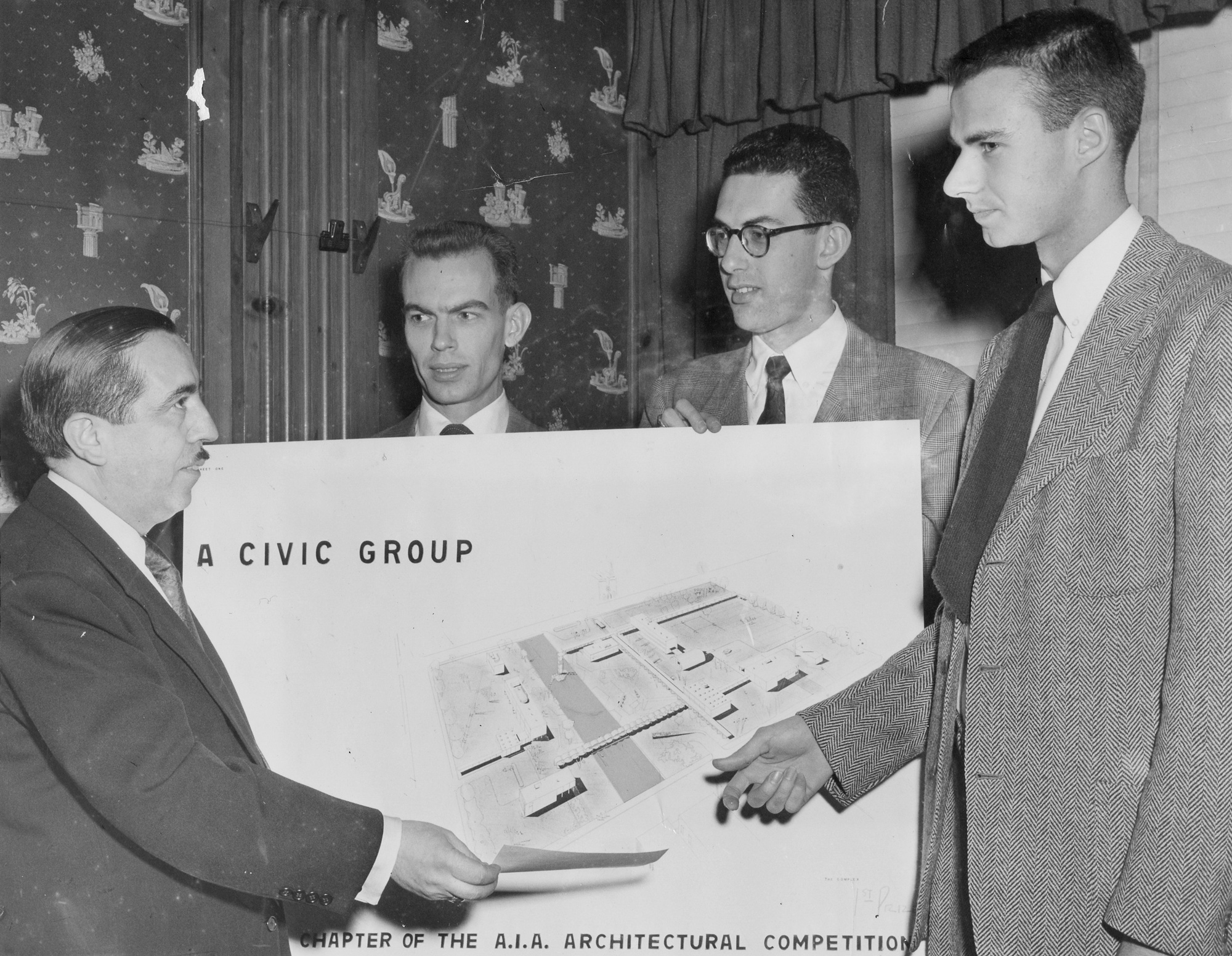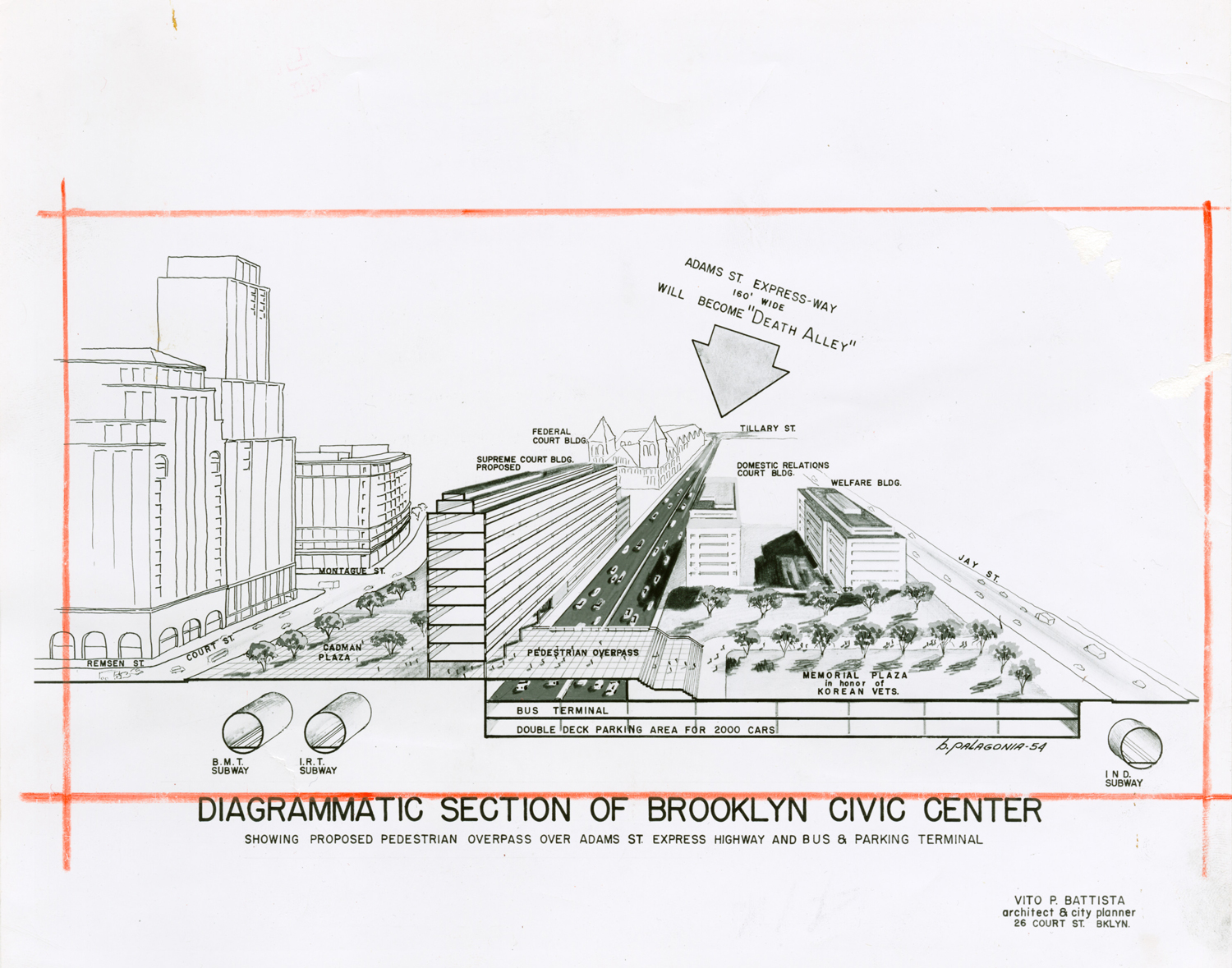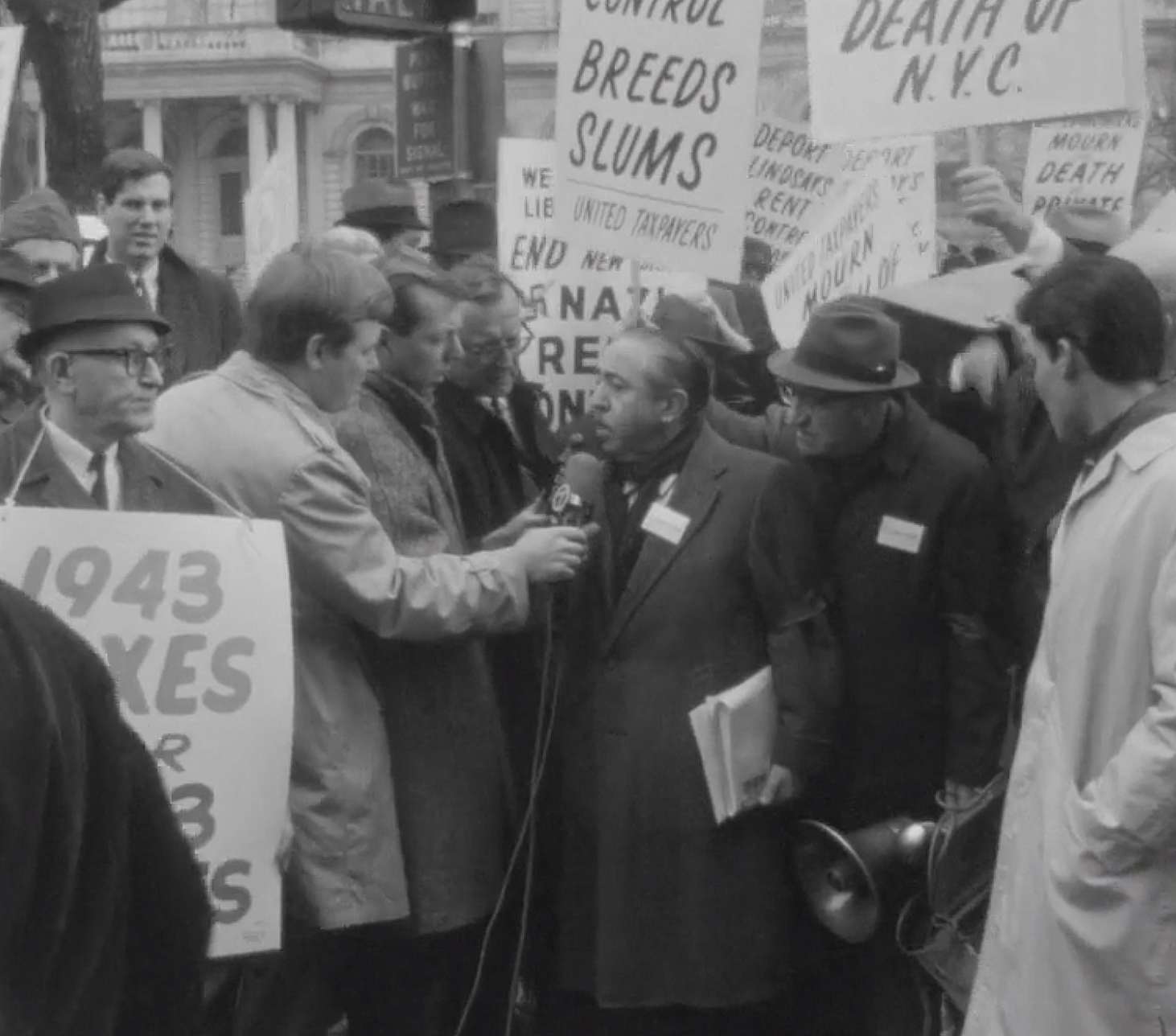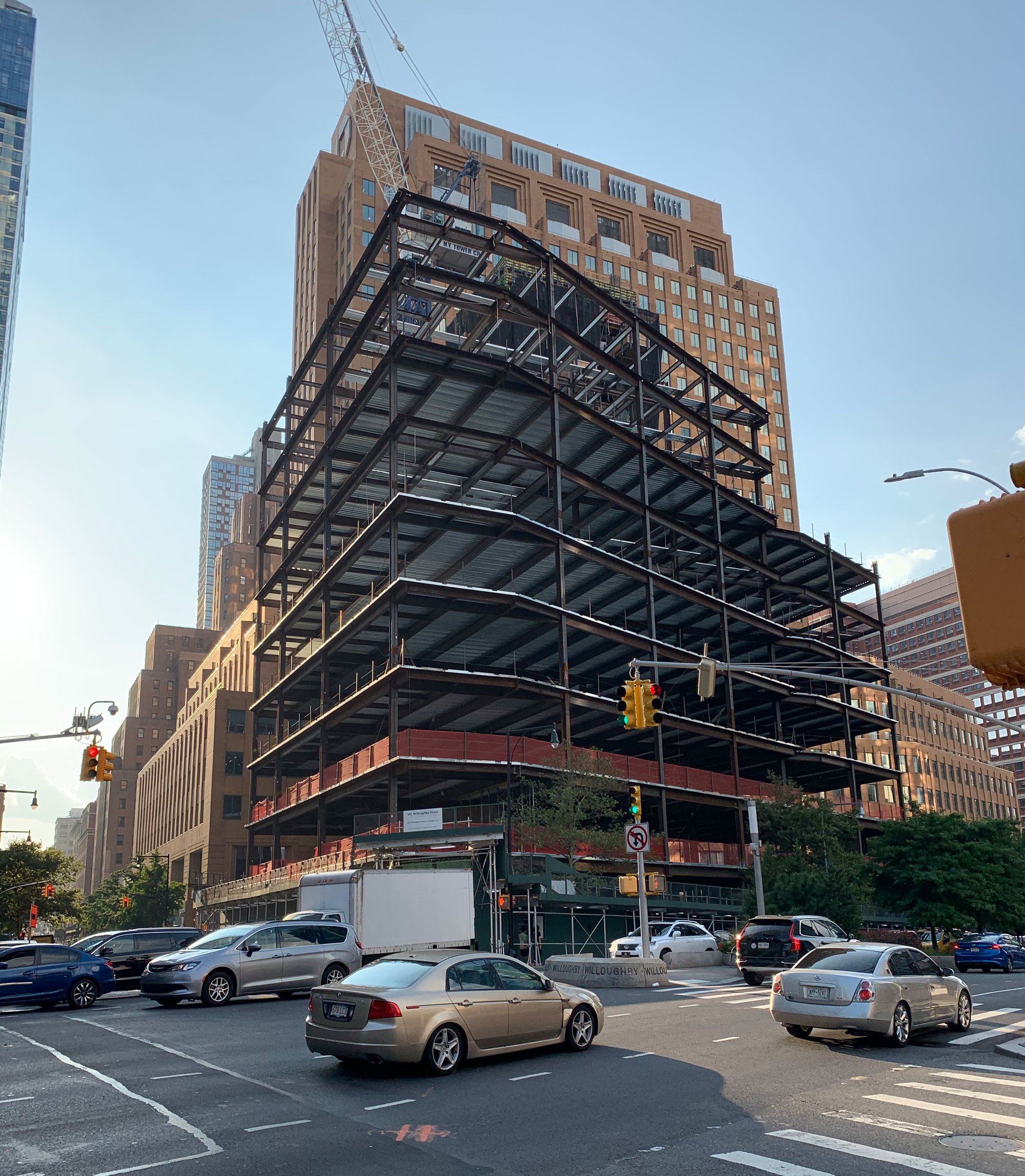
We are celebrating 15 years — and counting — of stories that are deeply researched and deeply felt, that build a historical record of what the city has been.
We are celebrating 15 years — and counting — of stories that are deeply researched and deeply felt, that build a historical record of what the city has been.
Between a so-called crime wave sweeping abolitionist rhetoric out of the mainstream discourse, and an emboldened real estate industry driving up rents across the boroughs, it would seem that New York is no longer reading a “tale of two cities.” Following years of unevenly-implemented progressive experiments, and one unforgettable summer of radical revolt, such a revanchist turn can feel a bit jarring. But in this moment, the story of one half-forgotten local politician rings familiar. It so happens, this figure was also, once upon a time, a prominent public architect. Vito Battista built a career riding the wave of public spending that reshaped New York City in the wake of the New Deal. Yet he would eventually, and forcefully, turn his back on the very idea of a “public,” championing the interests of private landlords while ridiculing racial integration efforts and forging a new, brash style of populist trolling that would fit comfortably within our own, post-Trump political landscape. Below, Rico Cleffi traces Battista’s unusual trajectory, from designing branch libraries to vitriolic right-wing politicking — an echo of the city’s own cyclical, reactionary tides, and a reminder of how closely New York’s complex politics are tied to the fate of its urban fabric.
By the time the Institute of Design and Construction (IDC) closed in 2015, Downtown Brooklyn was already replete with luxury condo towers and dominated by global capital and opaque real estate investment vehicles — a far cry from the days when the school trained thousands of builders, engineers, interior designers, and architects. Vito Battista’s trade school prided itself on generous scholarships and was known for helping architects to pass the city’s licensing exams (Philip Johnson took one of the IDC’s “cramming” courses). The IDC was but one facet in the life and work of Battista: a well-regarded public architect whose political and professional career spanned from the New Deal through the fiscal crisis years of the 1970s and the economic austerity of the ‘80s.
Battista would leverage his involvement as a designer of massive public works projects into a second life as a political performance artist against the welfare state, an arch foe of public housing and rent control, and a main opponent of police reform and school integration. The first right-wing media troll of the television age, Battista’s unique reactionary populism won over large sectors of New York’s white working-class half a century before Donald Trump would promulgate a similar ideology on a much larger scale.
Born in 1908, Battista immigrated from Bari, Italy as a child and left school to work with his father as an ice peddler. He eventually returned to school, financed, he claimed, with $20,000 he earned selling the ice business. He then earned a bachelor’s degree from Carnegie Tech, a master’s from the Massachusetts Institute of Technology, and spent time studying at the École de Beaux Arts in France and at Columbia University. Battista easily aced the city’s civil service architecture exams, landing a position at the Department of Public Works (DPW) where he worked as a draftsman on, among other projects, the 1939 World’s Fair. His test-taking acumen was no joke: a few years later Battista scored second on the exam to lead New York’s still-young Housing Authority. Feeling he was deserving of the position, he unsuccessfully sued the city in an attempt to vacate the appointment of the top-scorer, William Vladeck, as agency director.
This was a time of significant change in New York City. The January 28, 1941 issue of the City Record tells of the City Planning Commission’s Master Plan, undertaken to accommodate new factors like “the daily transportation of food and other supplies for a population of over seven million persons; the transportation of the products of their industry; and the movement of goods through the largest port in the world.” The Record also mentions the number of cars registered in the city had reached nearly a million in 1939, a five-fold increase from the start of the 1920s. Recently departed from the DPW, Battista found himself working in peak Robert Moses-era New York, with New Deal dollars flowing in and a reshaping of the city underway.
One key project developing in tandem with the city’s transformation into the world’s financial and manufacturing capital was the Brooklyn Civic Center: the swath of Downtown Brooklyn encompassing Cadman Plaza and its courthouses, and public-housing developments like the Farragut Houses. The Civic Center was regarded as “the largest post-World War II civic-center urban-renewal project in the country,” entailing massive slum clearance, large-scale public spending, and a near army of public and private workers.[1]
The Civic Center is a foundational myth in the Battista story, the locus from which all else unfolds. Battista regularly boasted of his involvement in the Center, though his name is absent from any of the city’s documents related to the project. At the time, he was working for architect Henry V. Murphy, whose firm had a hand in the Center’s design. He is often referred to as a “co-designer” of both the larger project and the Brooklyn Supreme Court building, officially designed by the firm of Shreve, Lamb and Harmon (the DPW didn’t begin crediting the individual architects it contracted with until 1957). Yet the Supreme Court building factors into much of the press that surrounded Battista during his lifetime, and the scant press since his death. The architect’s experiences working on public projects weren’t favorable: A June 1969 New York magazine profile mentions, “He left the city’s employ, he says, because he found out that ‘government is run by a bunch of guys who can drink a glass of beer with the boss, then put their names on your drawings. I saw I could never win against this thing.’”
Battista understood ramped-up post-war investment would require skilled workers. Following his involvement with the Civic Center, he bought a building in Downtown Brooklyn and launched the IDC in 1947. When he was named president of the Brooklyn chapter of the American Institute of Architects (AIA) in 1948, Battista had fully emerged as a public architect. Now regarded as an expert by newspapers across the city, Battista churned out elaborate designs for press-worthy projects, often weird, sometimes visionary. He promoted a combined parking garage/air-raid shelter for the Civic Center, and touted the merits of Quonset huts as a remedy to nuclear fallout. A more forward-thinking plan included a ban of large trucks from the city, to be replaced by a series of transit hubs on the outskirts of the boroughs. One of the more ambitious of Battista’s plans, a man-made “sports island” off Red Hook Flats, would house the Brooklyn Dodgers, Yankees and Giants. A dozen civic organizations publicly signed on, hoping to “Eliminate the need for the [Verrazzano] Narrows Bridge,” thus preventing the “condemnation and razing of 10,000 Bay Ridge homes, churches and businesses.” [2]
Newspapers heralded the common-sense architect with a knack for making complex issues understandable. Announcing their Man of the Week in November 1949, the Brooklyn Eagle proclaimed: “Civic Center Co-Designer Plans for a New Brooklyn.” “When a bigger and better Brooklyn is built, Vito P. Battista will have a hand in building it, and he has already started the hot rivets flying.” A one-man Department of City Planning in Exile, Battista regularly assailed the Civic Center project as a boondoggle. Citing the project’s lack of pedestrian walkways, he dubbed it “Death Alley.” The man who built his career on large-scale public projects turned into a fierce critic of government spending. By 1954, he was publicly calling for a stronger police presence in his neighborhood of Highland Park, Brooklyn. Telling a meeting of property owners of the need to “act before real blight sets in,” he warned of a situation where “property devaluates.” [3] His rhetoric soon expanded to encompass what would become two of his lifelong obsessions: rent regulations and public housing.
Despite a press at the ready to air his grand plans, city government wasn’t receptive. Most of the architect’s public design work was relegated to structures like the Borough Park Branch Library, or a firehouse on Union Turnpike in Queens. Completed in the ‘50s, these were the last of his public projects. Towards the end of the decade, Battista pivoted from making pronouncements to militant activism, coinciding with a burgeoning anxiety on part of property owners over racial integration. His increasingly populist politics were influenced by a network of civic organizations, business and property owners active throughout New York City since the beginning of the 20th century which viewed private property as near-sacred. To this coalition, hard-working “middle class” homeowners and successful business interests were held back by nefarious elites who manipulated a parasitic “underclass.” This was most evident in Battista’s later, constant assertions that social programs, especially public housing, were “the technique of the white liberal to enslave the black man.” [4]
In 1957, Battista merged two homeowner groups, the Property Owners of Brooklyn and the Property Owners Protective League, and became head of the new organization. He spun the new outfit into the United Taxpayers Party (UTP) and called for the resignation of Robert Moses, whose eager use of public domain made him the bane of property owners. In July of that year, he announced he was vying for the office of Brooklyn Borough President, then quickly abandoned the race for the first of many runs for mayor. Pushing a “civil rights program for the homeowner,” he promoted the selling off of New York’s public housing stock, which he claimed led to segregation “far worse than those our country is fighting in the deep south.” [5] Also in his platform was an early call for more aggressive policing, an end to rent control, limits on welfare benefits, and that perennial crank cause — opposition to water fluoridation. He would promote these issues for over three decades.
By this time, Battista had honed his ability to dispense with acerbic slogans. He’d spit out juicy, often improvised, quotes like “rent control is red control,” while pledging, if elected, to raze Gracie Mansion and replace it with a park. Newspapers’ willingness to exploit Battista’s antics didn’t square with the realities of machine politics. None of the papers that helped elevate him endorsed his mayoral campaign. At a campaign rally, he distributed flyers decrying a “blackout in the newspapers on my candidacy.” Days before the election, Battista abandoned any ambiguity in his rhetoric, telling the Daily News that “forcible integration of the city population” was the “principal issue in the mayoral campaign.”
Landing a distant third place in the race with 67,266 votes, the architect had set the template for another 20 or so electoral runs. Throughout this period, he would portray himself as a defender of the “forgotten man” against a system rigged by powerful elites, on multiple occasions even claiming to be a victim of election fraud. He declared “the tenant is a tax evader,” and under his leadership, busloads of irate landlords descended on Albany to protest rent control legislation. For all his deference to the sanctity of private property, Battista harbored a fierce resentment toward the ultra-rich. In 1959, he took to the Kings Courier to call out developer Fred Trump, whose massive Coney Island Village project he blasted as “the greatest property giveaway program since the Indians sold Manhattan for $24.” This same contempt was present in his later attacks on Governor Nelson Rockefeller (“the only thing he has is money”) and mega landlord Edward Sulzberger, who he saw as beholden to “urban renewal contracts” and indifferent to the needs of smaller property owners. Along similar lines, he’d regularly call for higher tax assessments on the type of luxury housing inhabited by top earners (though the large landlords benefitted most from his anti-regulatory politics). “Don’t be surprised,” he warned, “if one fine day the City decides to abolish the police force and requires private citizens to hire their own body guards.” [6] He had staked out a distinct rightist populism. In a 1961 Daily News profile, Batista cited as influences the oratory style of socialist Fiorello LaGuardia and the ideology of ultraconservative Barry Goldwater.
Above, listen to a 1969 New York magazine broadcast interview with then-comptroller candidate Vito Battista. This audio clip was published by the New York Public Radio Archive Collections, hosted by WNYC.
In an attempt to capitalize on the growing importance of television news, Battista enlisted the services of Howard Rubinstein; just starting out as a PR man, he had only one paying client (Rubinstein would later work for a young Donald Trump). As an original right-wing media troll, Battista was a natural. By 1960, he was carrying out stunts like marching a camel past City Hall as a protest against taxation. In February 1964, as Southern states vowed to resist federal integration mandates, Battista hosted a rally, ostensibly a celebration of Abraham Lincoln’s birthday. The event, he said, was an effort to bring “emancipation from the bondage of rent control.” [7] He walked the streets wearing a barrel. He paraded an elephant down Wall Street. The media ate it up. Meanwhile, the Worker, organ of the Communist Party USA, saw parallels between Battista’s tactics and rhetoric and southern segregationists, asking: “Aren’t we witnessing a build-up of powerful realty interests, in collusion with newspapers . . . to smear and to sabotage the progress of integration in both housing and in education? Aren’t we witnessing a northern White Citizens Council at its dirty work?”
In 1965, Battista jumped into a crowded mayoral race which featured, among others, Norman Mailer and William F. Buckley. A New York Times reporter understood his growing appeal with a new segment of the electorate. “Since the last election, groups such as the Parents and Taxpayers, which are opposed to busing school children to achieve school integration have multiplied in membership and influence. Mr. Battista’s campaign is aimed at these groups, at small businessmen, and property owners.” His early law-and-order rhetoric also made him popular with an NYPD resentful of any attempts at outside oversight. When he marched with 5,000 cops against a proposed civilian review board, the Times reported “the darling of the pickets seemed to be Vito P. Battista.”
After losing the election, Battista kept up the momentum. He led an estimated 600 landlords on City Hall in June 1967 in a raucous rally against a citywide rent control measure. The mob stormed the building, smashing windows and injuring a mayoral staffer. Despite this violence, his rhetoric began to pay off in areas of the city where working- and middle-class white voters were turning away from the Democratic Party. Scoring his first electoral victory in 1968, he won a State Assembly seat in the 38th District where registered Democrats outnumbered Republicans two-to-one. As a legislator, Battista was predictable: he put forward bills that would strip legal rights from tenants receiving public subsidies and introduced legislation to abolish rent control. His legislative record made him a top target for electoral defeat by the AFL-CIO. One of his repeated efforts was a bill that eventually died in committee, which would have outlawed use of terms like “Cosa Nostra” or “mafia” as ethnic slurs. He held hearings calling for an investigation of the city welfare system, framing social-service beneficiaries as a drain on taxpayers.
In 1969, he again ran as mayor in the primary, later accepting the comptroller slot on the Republican ticket. By now, Battista’s message resonated with white working-class New Yorkers who felt spurned by political elites and squeezed economically as the city moved away from manufacturing. Resentment towards gains made by the Civil Rights Movement and the fear of crime and urban riots made Battista’s rhetoric more widely accepted. In an April 1969 New York magazine article, journalist Pete Hamill described him as one of “two New York City politicians who most represent the discontent of the white working class” (the other was Queens Councilmember Matty Troy). The two, Hamill wrote, were “usually covered in the press as if they were refugees from a freak show . . . Battista claims to be the spokesman for the small homeowner and many small homeowners believe in him; but a lot of the people who are listening to him now see him as the spokesman for the small homeowner they would like to be.”
Battista didn’t win the 1969 election, but he continued to use his Assembly seat as a platform to amplify his views. As violent crime soared in the early ‘70s, he denounced the “near anarchy in the streets and subways,” caused by “turnstile justice” set in motion by “liberal Democrats who have forced busing of children and who in their concern for the criminal pay no attention to the victim.” [8] In September of 1970, when homeowners resisted the city’s plans to seize property by eminent domain in order to build schools in Corona, Queens. Battista jumped into the fray. He inserted himself into the fight led by middle class, mostly Jewish Forest Hills residents who vehemently opposed the construction of an affordable housing complex there.
Battista lost his Assembly seat in 1974, and by the time he jumped into the 1977 mayor’s race, his appeal had faded considerably. The man who had been railing against the welfare state since the ‘50s didn’t stand out much in the ‘70s, when even mainstream politicians fell over themselves to blame the city’s fiscal crisis on unions and social spending. He continued his activism into the ‘80s, receiving “thunderous cheers and applause” when he spoke to an East New York demonstration against a homeless shelter opposed by members of the mostly Black and Latino neighborhood in 1981. The demonstrators agreed with his claims that the City was attempting “to get all the homeless men off the Bowery so they can put high-rise buildings there and somebody can make billions of dollars off your backs.”
Battista was no longer on the margins. Much of his ideology found mass acceptance with the election of Ronald Reagan, and, in 1984, Reagan himself appointed Battista to a national regulatory body: the Architectural and Transportation Compliance Board. Later that decade, Congressional Black Caucus member Edolphus Towns commemorated the “businessman, educator, architect, humanitarian, and civic leader,” who was a “personification of the tenets of the American Dream.” After his death at the age of 81 in 1990, the New York City AIA’s Oculus and the New York Times ran positive obituaries. The Times eulogized him as a populist champion, who “appeared to his critics and those stung by his barbs as a noisy obstructionist. But when he went up against the politicians, armed only with sheafs of papers and envelopes, he spoke out like a giant, a champion of the downtrodden, unafraid to challenge powerful interests.” Seen through the lens of the Reagan-Bush years, the revanchist crusader didn’t appear such an aberration.
A 2004 rezoning of Downtown Brooklyn designated the IDC as one of the buildings slated for seizure via Battista’s bête noire, eminent domain. Battista’s son Vincent, also an architect and head of the IDC, fought the city’s plans, and prevailed. A decade later, he sold the building and closed the Institute, relaunching it as the IDC Foundation. It is helmed by two of Battista’s children, who appear committed to funding education, and who have so far put a good chunk of the $28 million from the building sale toward millions in grants to schools including NYU, Cooper Union, and Columbia, which has a professorship bearing the IDC name. (All three schools are the type of large landlords Battista despised; Columbia and NYU are among the top private property owners in the city.) The old IDC building was razed to make way for a 24-story tower, scheduled for a 2023 completion.
A stone’s throw away, tenants will soon be moving into Brooklyn’s first supertall — a 1,066-foot-high paean to wealth. The largest reimagining of Brooklyn since the Civic Center era is well underway. The days of grand public projects like those that Battista came up with are long gone, and his beloved small landlord barely exists anymore. His old neighborhood in Brooklyn is represented by a socialist-feminist Latina in the State Senate, but Battista’s political legacy lives on. A rhetoric and ideology similar to Battista’s has yielded major electoral results in recent years. Donald Trump owes an obvious debt to Battista. Traces of his influence can even be seen in New York Mayor Eric Adams, a law-and-order ex-cop who routinely invokes the plight of Battista’s mythical small landlord in opposition to rent freezes and pro-tenant legislation. Vito Battista would have enjoyed the irony of it all.
The author would like to thank the many librarians who helped unearth materials used in this article, including the staffs of the New York State Library, the Brooklyn Public Library’s Center for Brooklyn History, the New York City Municipal Archives, and the Brooke Russell Astor Reading Room at the New York Public Library.
Francis Marrone, An Architectural Guidebook to Brooklyn (Kaysville: Gibbs Smith, 2001), 20.
“12 Civic Groups Back Island Stadium Plan,” Greenpoint Weekly Star, May 25, 1956, 5.
“More Foot Cops Asked in Highland Park Area,” Brooklyn Eagle, March 26, 1954, 23.
“Mr. Vito Battista,” NYPR Archives Collections, May 28, 1969.
“Piluso Leads Phone Campaign for Vito Battista,” Brooklyn Record, August 16, 1957, 1; “New Public Housing Opposed,” New York Times, September 25, 1957, 21.
“Will Picket City Hall on Sidewalk Law,” Kings County Chronicle, March 29, 1960, 10.
“Lincoln’s Birth is Marked in City,” New York Times, February 13, 1964, 31.
“Rally Will Protest ‘Reign of Terror,’ Daily News, September 30, 1970, 55.
The views expressed here are those of the authors only and do not reflect the position of The Architectural League of New York.



